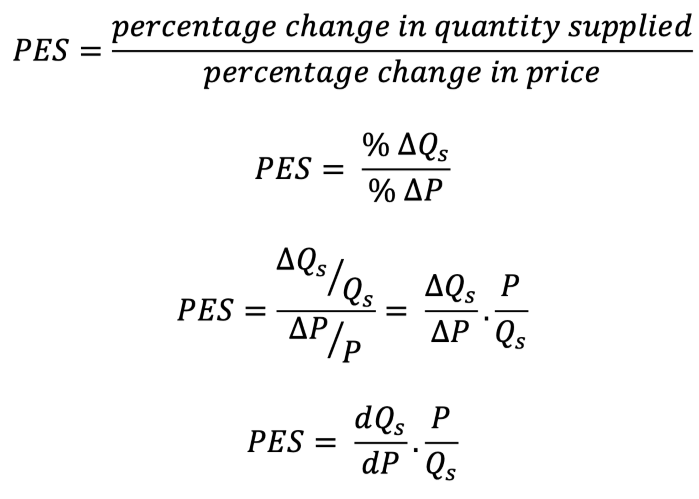Economics HL 2.1-2.3, 2.5-2.6 Microeconomics
Marginal rate and substitution
MRSxy = oppurtunity cost, slope of indifference curve
A series of optimal consumer choices provides the theoretical basis for an individual demand curve
Diminishing marginal utility
as we consume more of a good, the satisfaction we derive from 1 additional unit decreases
rate of satisfaction diminishes with every 1 unit
examples: food, cars
Indifference curves
IC always has a negative slope if consumer likes both goods
IC cannot intersect
Every good can lie on one IC
ICs are not thick
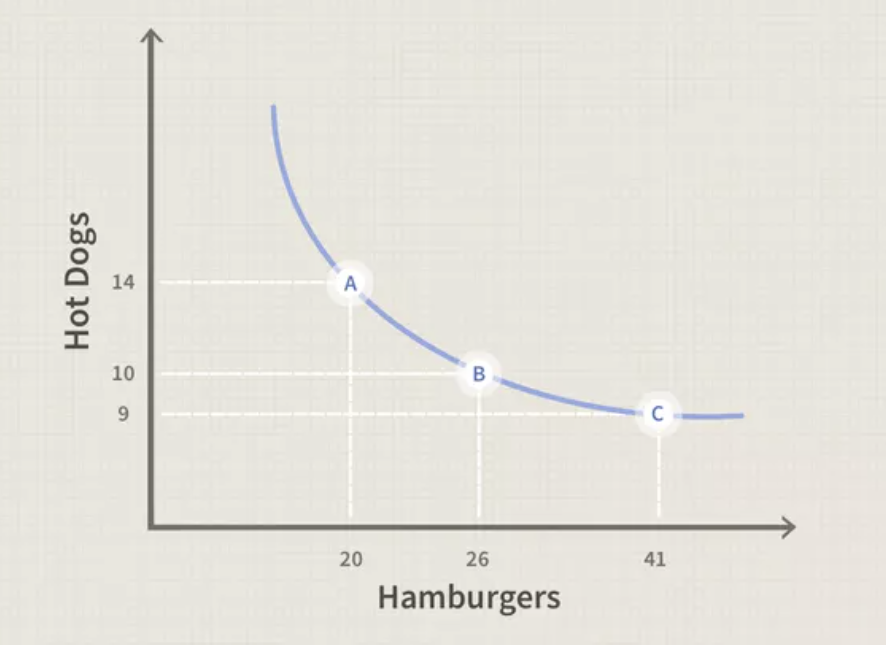
Demand Theory
Substitute effect
Measures of consumer MRSxy, before and after the price change
Amount of additional food the consumer would buy to achieve the same level of utility (assuming a price decrease in one good)
Moving from one optimal curve to another
Steps:
Identify initial optimum basket of goods
Identify final optimum basket of goods, after the price change
Identify the decomposition optimum basket (DOB), attributed to the substitution effect
DOB must be on a BL that is parallel to BL2 following the price change
Assume that consumer retains same level of utility after the price change
Income effect
Accounts for price change by holding the consumer’s purchasing power (following price change) constant and finding an optimum bundle on a new (higher/lower) utility function
Purchasing power - number of goods/services that can be purchased with a unit of currency (falls when price increases)
Measured from the DOB (B and Xb) to the final optimum bundle, following price change (C and Xc)
Both effects move in the same direction
Law of Demand
At a higher price, consumers will demand a lower quantity of a good (vice versa)
Relates to diminishing marginal utility by compensating (off-set) DMU must be negatively related to quantity
Inverse relationship of price and quantity
Given the presence of diminishing marginal utility, in order to promote increased consumption, prices must fall
For a “normal good,” the increase in consumption results from a fall in price - this is driven by:
a lower MRSxy, while remaining on the same IC generates increased consumption of good X (substitute effect)
the theoretical increase in income necessary to lift the consumer to the higher IC, while keeping the ratio of prices at the new level (income effect)
Economic theory of demand always starts at the individual level. A horizontal summation of many individual demand curves provides a market demand curve. Market demand curves are always less steep than individual demand curves
Determinants of Demand
Income
Price of substitutes/complements
Number of consumers
Preference or tastes
These factors cause a market demand curve to shift (change in demand)
Individual Demand Curve
a series of optimal choice bundles across different price levels (shown on price-quantity graphs)
Inferior Good
whether the substitution effect or income effect dominates in an empirical not theoretical question
Opposite of a normal good, demand falls when income rises
Non-price determinants of demand
income (normal good)
income (inferior good)
preferences/tastes
price of substitute/complement goods
number of consumers
Perfect Competition
Economic profit maximization is the assumed goal of private firms
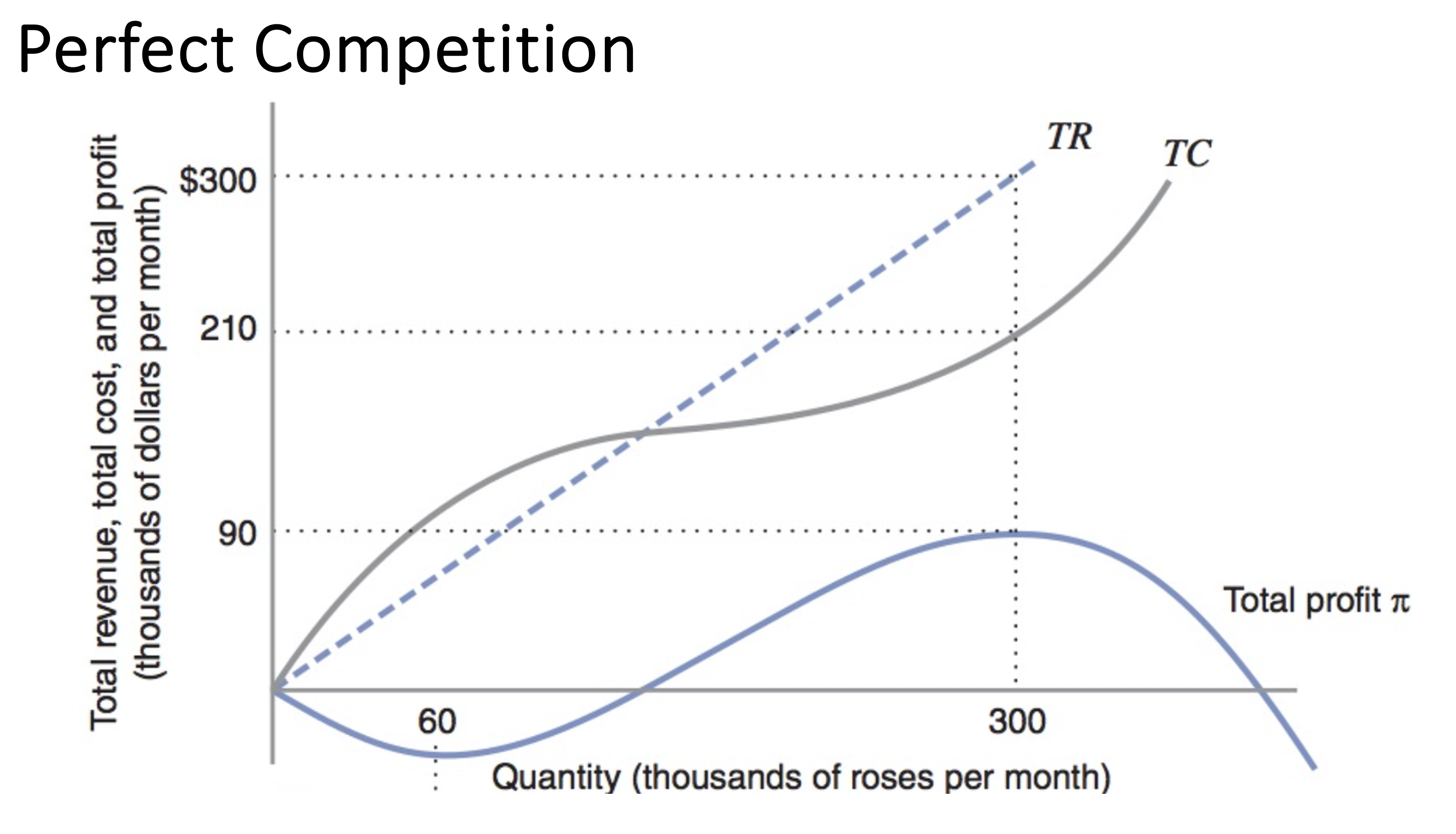
Total cost represents the most efficient combination of inputs for a given level of output
The rate at which total revenue (TR) changes with respect to change in output (Q) is marginal revenue (MR)
MR = TR/Q = (Q*P)/Q = P
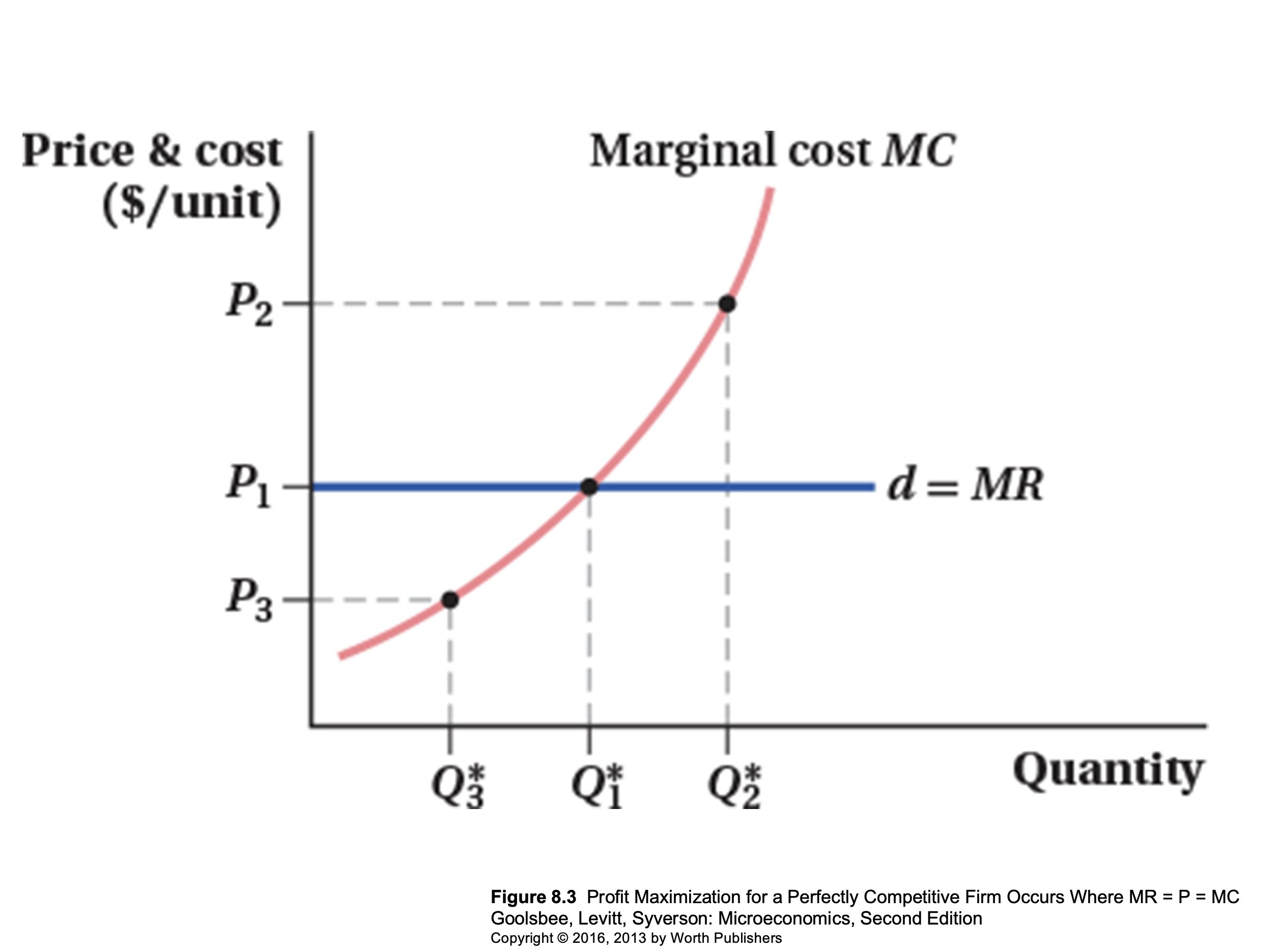
Profits are maximized when marginal revenue = marginal cost
After the point where MR=MC, your profits will be negative
Supply = MC, total cost optimized
Market Equilibrium
the intersection of the demand and supply curves
total cost is important as it is the basis of an individual firm’s supply curve
upward sloping section of the marginal cost curve is the supply curve
Efficiency of demand/supply curves
Supply curves
Optimal combination of cost-minimizing inputs for each level of output
Demand curves
Optimal combination of utility-maximizing goods for a given level of income
Market supply curve
Horizontal summation of a series of individual supply curves
Supply Theory
Supply - total amount of goods and services that producers are willing and able to purchase at a given price in a given time period
Law of Supply
as the price of a product rises, the quantity supplied of the product will usually increase (ceteris paribus)
firms attempt to maximize product by increasing quantity supplied when the price is higher (and vice versa)
Non-price determinants of supply
Changes in costs of factors of production
Prices of related goods
Indirect taxes and subsidies
Future price expectations (producer)
Changes in technology
Number of firms
Shocks
Markets only work when there is strong competition
Market Equilibrium Graphs (supply + demand)
Consumer Surplus (C.S.) - willingness to pay and what they did pay
Producer Surplus (P.S.) - difference between market price and lowest price a producer uses to produce
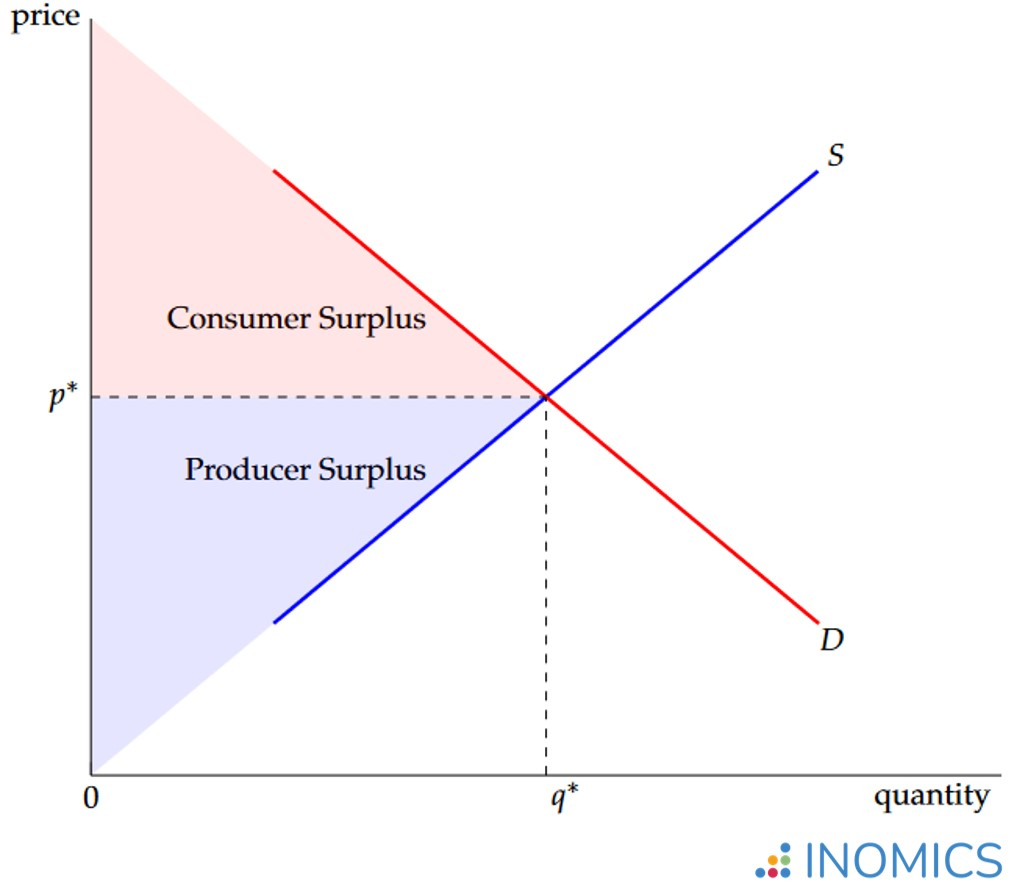 Assumptions of perfectly competitive markets
Assumptions of perfectly competitive markets
all actions (consumers/producers) have access and fully process all relevant information
there are many small buyers and producers - all with equally negligible market power
all actors are rationally self-interested
Welfare - theoretical surplus value left with different economic agents (consumers, firms, governments)
Production - market clearings
Optimal Allocation
MR = MB (marginal benefit)
Social surplus = consumer + producer surplus
In a perfectly competitive market, social surplus is at its largest
Analysis of surpluses are called “welfare analysis”
Price Mechanism Functions
A - allocation (resources are allocated to those who need it most)
R - rationing (not everyone in the market gets what they want, only those who have the same valuation of the product as the firms)
S - signaling (communication of information that drives other factors)
I - incentive (capitalist system is driven by incentives)
2 Demand Curves
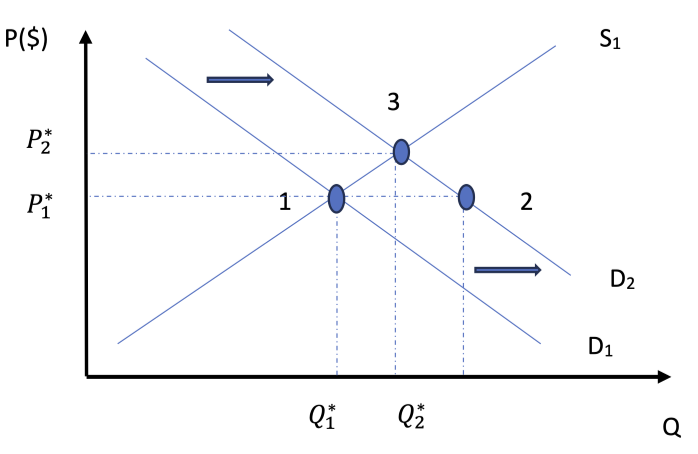
2 Supply Curves
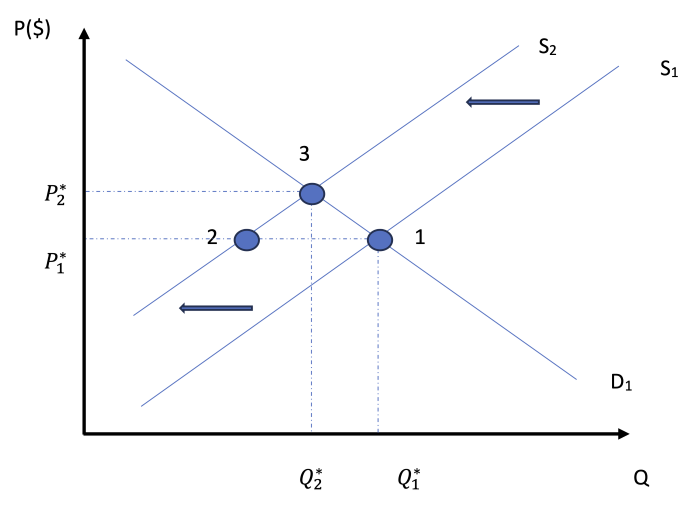
Moving from point 1 to point 3 on both graphs
Point 2 has excess supply/demand
ARSI to move to the new equilibrium point
At both equilibriums, there is optimal allocation
Structure of Microeconomics
How do consumers and producers make choices in trying to meet their economic objectives?
Demand
Supply
Competitive market equilibrium
Elasticities of Demand
Elasticities of Supply
Critique of the maximizing behavior of consumers and producers
interaction between consumers and producers determine where resources are directed
welfare is maximized if allocative efficiency is achieved
constant change produces dynamic markets
consumer and producer choices are the outcome of complex decision making
When are markets unable to satisfy important economic objectives - and does government interaction help?
Role of government in microeconomics
Market failure
externalities and common pool or common acess resources
public good
asymmetric information (imbalanced information held by consumers and/or consumers)
market power (single/small number of suppliers)
Price Elasticity of Demand (PED)
measure of the responsiveness of the quantity demanded of a good subject to the change in price
Percentage change and differentiation to calculate
PED = percentage change in quantity demanded / percentage change in price

|PED| > 1 demand is relatively elastic
|PED| < 1 demand is relatively inelastic
|PED| = 0 demand is unitary
PED = ∞ perfectly elastic
PED = 0 perfectly inelastic
How can PED change along a straight line?
as you move along the x-axis, it gets less elastic
as quantity increases, elasticity decreases
How does PED change across income levels?
more elastic for lower income groups
elasticity depends on the good (price-quantity relationship)
quantity demanded changes, but not the demand curve
“staples” are essential, less elastic
Determinants of Price Elasticity of Demand (PED)
number of close substitutes; more subs = increased price sensitivity
luxuries VS staples
time - purchases made with longer time periods are generally more elastic
proportion of income spent on the good
Income Elasticity of Demand (YED)
measure of how much demand for a product changes when there is a change in the consumer’s income
YED = percentage change in quantity demanded / percentage change in income
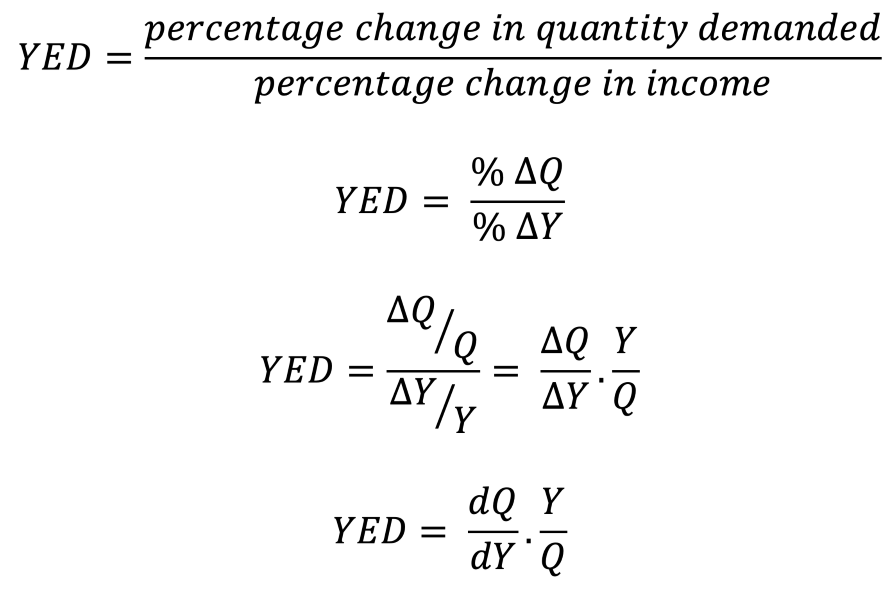
YED to categorize inferior and normal goods
Engel Curve

axes → income and quantity
YED > 1 luxury/service
YED < 1 necessity
YED > 0 normal good
YED < 0 inferior good
quantity demanded when income increases also increases then diminishes and goes backwards
if you continue a segment AB with the same slope and that line cuts the y-axis, then it is a luxury
if it cuts the x-axis, it is a necessity
only works on income = y and quantity = x
Primary Commodities
raw materials (cotton, coffee)
inelastic demand (they are necessities)
consumers are not everyday households, but manufacturers
Manufactured Goods
made from primary commodities
more elastic, as there are more substitutes
Why is YED important?
For firms:
products with a high YED will see a demand increase when income increases (used to see maximum profit based off changes in income)
allocation of resources to fit income groups in products
if income falls, production of inferior goods increase because of YED rules
Sectoral changes
primary sector: agriculture, fishing, extraction (forestry, mining)
secondary sector: manufacturing, takes primary products and uses them to manufacture producer goods (machinery, consumer goods) also includes construction
tertiary sector: service, produces services or intangible products (financial, education, information, technology)
shifts in the relative share of national output and employment
as countries grow and living standards improve, there is a change in proportion of the economy that is produced
extra income is spent on manufactured goods as the demand is more elastic than the primary products (using YED to measure/verify) ← same goes for the service sector
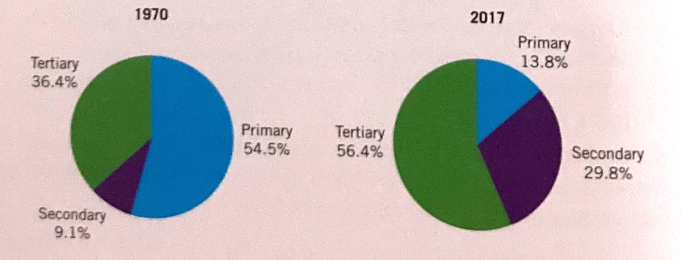
Price Elasticity of Supply (PES)
PES = percentage change in quantity supplied / percentage change in price
